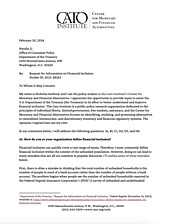To Whom It May Concern:
My name is Nicholas Anthony and I am the policy analyst at the Cato Institute’s Center for Monetary and Financial Alternatives. I appreciate the opportunity to provide input to assist the U.S. Department of the Treasury (the Treasury) in its effort to better understand and improve financial inclusion. The Cato Institute is a public policy research organization dedicated to the principles of individual liberty, limited government, free markets, and peace, and the Center for Monetary and Financial Alternatives focuses on identifying, studying, and promoting alternatives to centralized, bureaucratic, and discretionary monetary and financial regulatory systems. The opinions I express here are my own. In my comments below, I will address the following questions: A1, B1, C1, D4, D5, and D6.
In my comments below, I will address the following questions: A1, B1, C1, D4, D5, and D6.
A1. How do you or your organization define financial inclusion?
Financial inclusion can quickly cover a vast rangeof issues. Therefore, I most commonly define financial inclusion within the context of the unbanked population. However, doing so can lead to many mistakes that are all too common in popular discourse. I’ll outline some of these mistakes below.
First, there is often a mistake in thinking that the total number of unbanked households is the number of people in need of a bank account rather than the number of people without a bank account. The problem begins when people see the number of unbanked households reported in the Federal Deposit Insurance Corporation’s(FDIC’s) survey of unbanked and underbanked households. People often see the headline number and begin to craft policy solutions. However, the initial number is not the full story.
As the FDIC goes on to explain in the report, it also asks the unbanked population about their interest in acquiring a bank account. In the latest report, 72 percent of the unbanked households were uninterested in having a bank account (Figure 1).

This work is licensed under a Creative Commons Attribution-NonCommercial-ShareAlike 4.0 International License.

